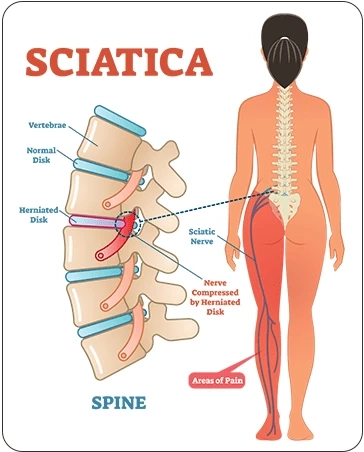Sometimes, you feel pain in your lower back that extends to the hips and goes down to your leg. It may be confusing sometimes to understand what kind of pain this is. It can be sciatica. It is critical to be aware of sciatica pain, assess it promptly, and begin sciatica treatment on schedule.
One of the most effective ways of treating sciatica is through physiotherapy. It can relieve this kind of pain. Let us learn about sciatica and how physiotherapy can help with it.
What Is Sciatica?
Sciatica is the pain that radiates along the path of the sciatica nerve and reaches the hips, buttocks, and legs, causing irritation, inflammation, and injury. The person may experience various symptoms, including medium to intense pain, weakness, and numbness in the lower back, buttocks, and leg. They may also feel tingling or pins and needles sensations in the legs, toes, and feet. In extreme conditions, the person may lose bowel control and feel pain with the movement.
What Causes Sciatica?
The common reasons that can cause sciatica include many medical conditions, such as:
- A slipped or herniated disc
- Degenerative disc disease
- Spondylolisthesis
- Osteoarthritis
- Spinal Stenosis
How Can Physiotherapy Help With Sciatica Treatment?
Physiotherapy is one of the most effective non-surgical ways to get rid of the pain in your sciatica. The sciatica treatment plan in physiotherapy combines strengthening, stretching, and aerobic conditioning. The goal behind the physical therapy is:
- Boost the strength of your spine and the muscles in your hips, lower back, abdomen, and buttocks.
- Strengthens the core
- Enhance flexibility in the muscles through stretching
- Enhance nutrient flow in the body through light aerobics, such as walking, swimming, or pool therapy.
Let us understand physiotherapy interventions in sciatica.
Evaluating Effectiveness
Various research studies have demonstrated that physiotherapy is very effective in treating sciatica. Exercises and aerobic techniques reduce the need for surgery and facilitate faster recovery.
Patient-Centered Outcomes
Before creating a physical therapy plan for the patients, it is essential to understand the symptoms and causes of sciatica. Understanding the underlying reason enables therapists to develop physical therapy sessions that improve mobility, lessen pain, and improve patients\' quality of life. It is a holistic approach that not only addresses the physical symptoms but also helps the emotional and psychological well-being of the person.
Techniques
The physiotherapy techniques include:
- Manual Therapy: It includes hands-on techniques such as spinal manipulation and mobilization that help in proper spine alignment, reduce nerve compression, and improve joint mobility.
- Exercise Therapy: Some exercises particularly focus on strengthening core muscles, improving flexibility, and promoting proper posture. Practicing these exercises under the guidance of experts relieves pressure on the sciatica nerve.
- Modalities: various other methods, such as heat and cold therapy, help alleviate pain, reduce inflammation, and promote tissue healing.
- Education And Ergonomics: With the help of physiotherapy, patients learn about posture correction and lifestyle modifications that play a vital role in maintaining healthy spinal.
Conclusion
To sum up, out of all the non-surgical methods for treating sciatica, physical therapy has proven to have efficacy. For further guidance, consult the experts of top healthcare centers, like ANSSI Wellness, and get the best non-surgical sciatica treatment with their refined techniques.



